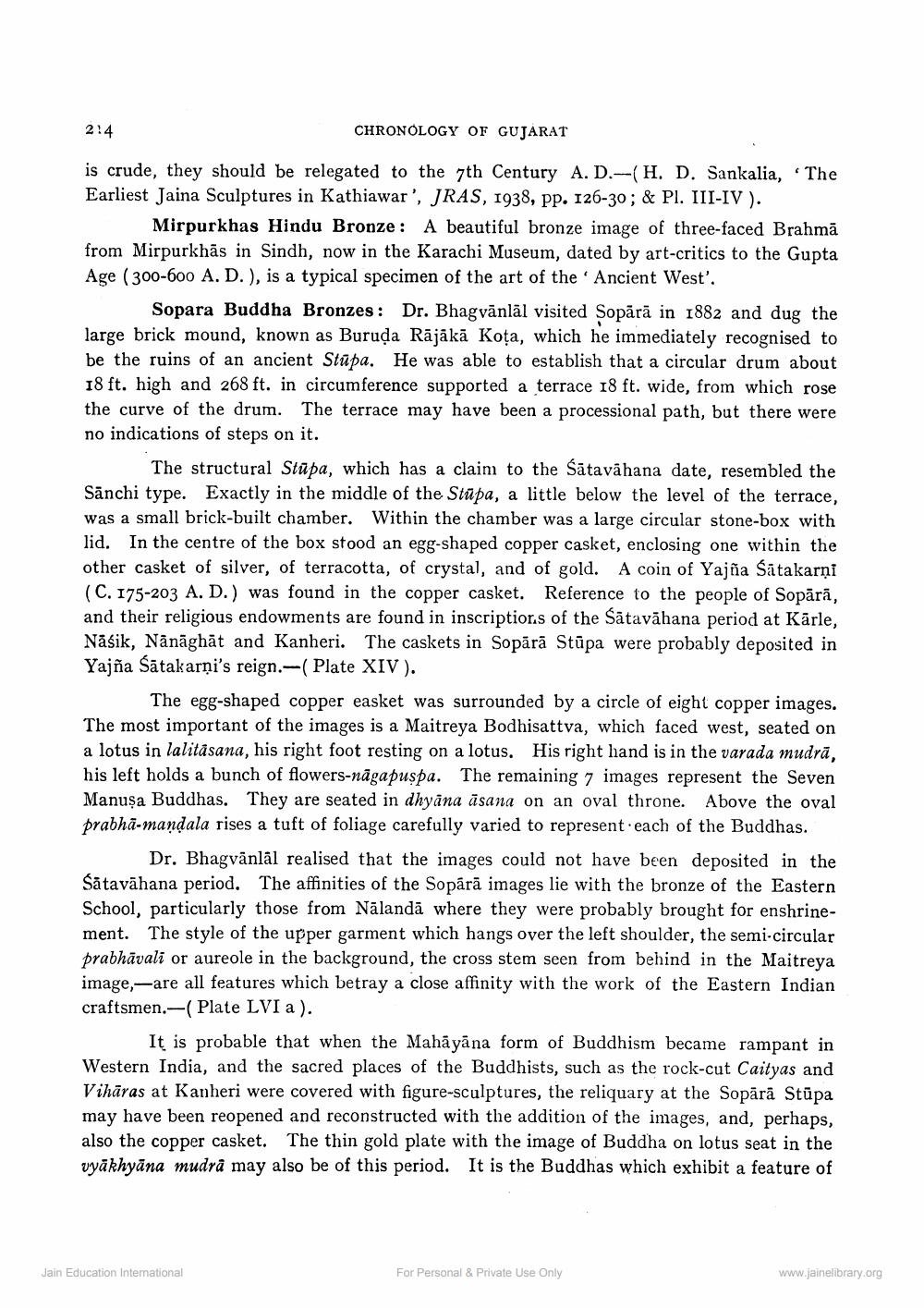________________
CHRONOLOGY OF GUJARAT
is crude, they should be relegated to the 7th Century A. D.-(H. D. Sankalia, The Earliest Jaina Sculptures in Kathiawar', JRAS, 1938, pp. 126-30; & Pl. III-IV).
2:4
Mirpurkhas Hindu Bronze: A beautiful bronze image of three-faced Brahma from Mirpurkhas in Sindh, now in the Karachi Museum, dated by art-critics to the Gupta Age (300-600 A. D.), is a typical specimen of the art of the Ancient West'.
Sopara Buddha Bronzes: Dr. Bhagvanlal visited Sopärä in 1882 and dug the large brick mound, known as Buruda Rājākā Kota, which he immediately recognised to be the ruins of an ancient Stupa. He was able to establish that a circular drum about 18 ft. high and 268 ft. in circumference supported a terrace 18 ft. wide, from which rose the curve of the drum. The terrace may have been a processional path, but there were no indications of steps on it.
The structural Stapa, which has a claim to the Satavahana date, resembled the Sanchi type. Exactly in the middle of the Stapa, a little below the level of the terrace, was a small brick-built chamber. Within the chamber was a large circular stone-box with lid. In the centre of the box stood an egg-shaped copper casket, enclosing one within the other casket of silver, of terracotta, of crystal, and of gold. A coin of Yajña Satakarni (C. 175-203 A. D.) was found in the copper casket. Reference to the people of Sopără, and their religious endowments are found in inscriptions of the Satavahana period at Kärle, Nasik, Nanaghat and Kanheri. The caskets in Sopärä Stupa were probably deposited in Yajña Satakarni's reign.-( Plate XIV).
The egg-shaped copper easket was surrounded by a circle of eight copper images. The most important of the images is a Maitreya Bodhisattva, which faced west, seated on a lotus in lalitasana, his right foot resting on a lotus. His right hand is in the varada mudra, his left holds a bunch of flowers-nagapuspa. The remaining 7 images represent the Seven Manusa Buddhas. They are seated in dhyana asana on an oval throne. Above the oval prabha-mandala rises a tuft of foliage carefully varied to represent each of the Buddhas.
Dr. Bhagvanlal realised that the images could not have been deposited in the Satavahana period. The affinities of the Sopără images lie with the bronze of the Eastern School, particularly those from Nālandā where they were probably brought for enshrinement. The style of the upper garment which hangs over the left shoulder, the semi-circular prabhavali or aureole in the background, the cross stem seen from behind in the Maitreya image, are all features which betray a close affinity with the work of the Eastern Indian craftsmen. (Plate LVI a).
It is probable that when the Mahayana form of Buddhism became rampant in Western India, and the sacred places of the Buddhists, such as the rock-cut Caityas and Viharas at Kanheri were covered with figure-sculptures, the reliquary at the Sopārā Stūpa may have been reopened and reconstructed with the addition of the images, and, perhaps, also the copper casket. The thin gold plate with the image of Buddha on lotus seat in the vyākhyāna mudra may also be of this period. It is the Buddhas which exhibit a feature of
Jain Education International
For Personal & Private Use Only
www.jainelibrary.org




